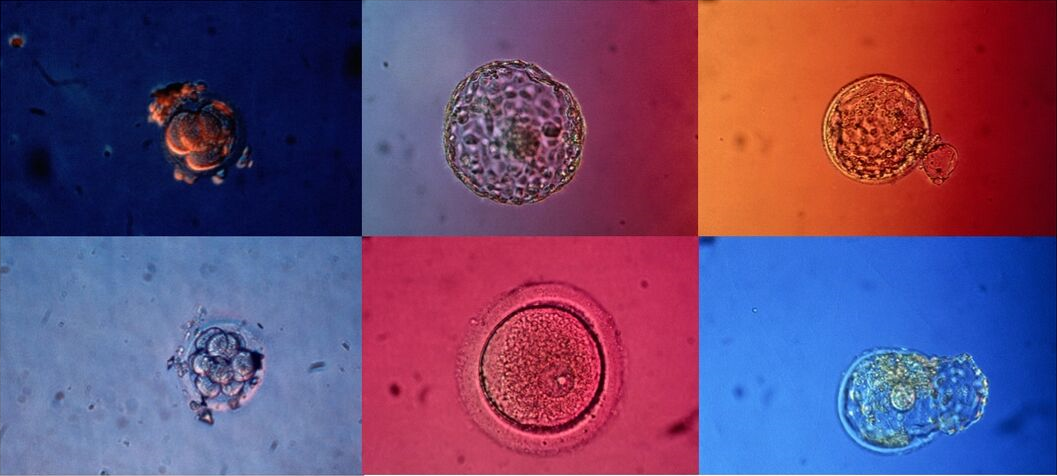Natalie Silverman, founder and voice of the Fertility Podcast, led the audience through our first event ‘Visions of Reproduction’ where speakers shared and discussed a wide range of videos, pictures, drawings, prints and embroideries of embryos, foetuses, pregnancy tests, pregnant and not pregnant bodies.
As part of this event, we ran a poll among the audience asking them (anonymously) to enter three images about reproduction that they had come across in their life. We received so many fascinating responses! Pregnancy tests, ultrasound and embryo were definitely the most chosen words, but people had also come across paintings, celebrity pregnancy photos, a real-life foetus-museum, 3D scans and many more. People are confronted with reproductive images multiple times in their lives and in very different situations.
Josie Hamper, from our research team, opened the event by presenting some unpublished results from the study. She launched a poll where the audience was invited to select the correct description for an image shown on-screen. People selected almost all available answers, including: A human embryo; An IVF embryo; Eight cell embryo; Grade one embryo; A potential baby; and baby’s first picture. It was revealed that all answers did in fact describe the image and that the diverse responses reflect different perspectives according to people’s expertise, experience or agendas. Josie accompanied the audience through the data of her own research on IVF patient’s experiences of receiving time-lapse videos of embryo development. She illustrated how videos may be welcome by some who receive them, while creating more uncertainties for others, especially if they feel unequipped to interpret what they are seeing. She ended by inviting a more nuanced public discussion around time-lapse embryo imaging technology, and the use of the videos and images that derive from this technology, beyond the clinic.
This question was taken up by Tabitha Moses who talked about her artwork around IVF experiences, involving photography and intricately embroidered hospital gowns. She accompanied the audience through the experience of various visualising technologies throughout infertility journeys, IVF treatments and pregnancy loss, and she discussed the possibility of trusting or privileging the feeling of a pregnancy through quickening or other embodied sensations, including those of pregnancy loss, over the images produced through medical technologies.

Isabel Davis developed the theme of vision versus feeling in her talk on the history of potential pregnancy. She dealt with the experience of un-pregnancy, meaning the condition of not really being pregnant yet but possibly being, through the work of natural scientist William Harvey on non-generation. Isabel’s talk prompted us to reflect upon ambiguous moments after a non-protected heterosexual intercourse takes place or after an embryo transfer where someone may wonder whether or not a pregnancy has started. These are all important dimensions of reproductive imagination and experience.
The topic of the uncertain time where pregnancy is not (yet) but could be is something Liv Pennington also reflected on when she talked about her artwork on pregnancy tests and the challenges of photographing them on different occasions. Liv’s talk accompanied the audience through her performative artwork Private View, which took place in 2002 and in 2019, and how the performance differed in so many ways between these dates as people’s relationships to pregnancy tests, images and sharing have changed, for instance through the increased familiarity with sharing and commenting on images via social media. Liv reflected on how visualising a pregnancy test result opens up possibilities that may change over time and how this makes her work controversial because of the vulnerability involved in exposing someone’s private reproductive moment while acknowledging the dynamic and uncertain process of pregnancy.

Funnily enough, technical issues prevented Liv from sharing her slides with the audience, which meant that we relied on Liv’s descriptions of her images, her facial expressions and ability to represent pictures through words. An experience that turned out to be powerful for an event on visualisation!
Nick Hopwood was the last speaker on the panel. His contribution proposed a long-term historical perspective on images of embryos and foetuses to unpack how the ordering of these along a narrative of development has, since the late eighteen century, come to stand for the course of a pregnancy. Nick underlined how images of reproduction produced over the last centuries have overwhelmingly represented a linear process, leaving out experiences of miscarriage or unsuccessful stories of fertility treatment, both of which are frequent ‘events’ in people’s reproductive lives, but underrepresented and thus erroneously considered the exception.
A conversation among all the speakers, with questions asked by the audience, allowed everyone to engage with the common threads or connections among such different approaches to common and less common reproductive images. The conversations highlighted how these images evoke questions of temporality in reproductive processes; how selection and standardisation have been embedded in the use and fruition of images concerning reproduction in the last centuries; and how images have been used for defining normality, normal variations and abnormality. The talks and discussion especially emphasised how a certain production and use of images facilitates the diffusion of dominant narratives of reproduction, leaving out meaningful and relevant experiences, which do not find space in the public representation.
—
We are exceptionally grateful to all the speakers and the audience who made this panel so engaging and rich in content. We also want to extend our thanks to the Centre for Public Engagement at Queen Mary and the Being Human Festival for making this event possible.
Keep an eye out for further details about our next events!
